Ukraine holds out despite stalled US aid, fears ‘deep advances’ by Russia
Kyiv’s forces manage to largely halt a four-week advance as pro-Ukrainian Russian forces launch cross-border attacks.
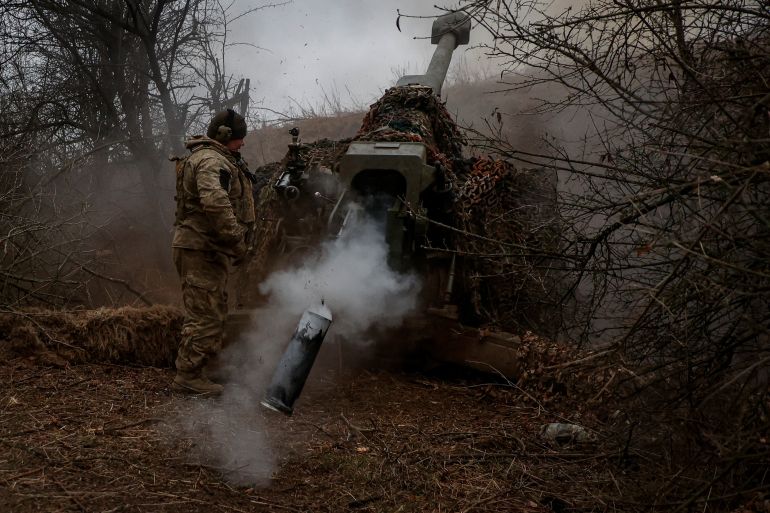
Russian rhetoric has been dialled up in the run-up to President Vladimir Putin’s expected re-election.
Putin reminded the world of Moscow’s nuclear readiness, and military reporters amplified battlefield skirmishes against Ukrainian defenders.
Keep reading
list of 4 itemsAnti-Putin paramilitaries claim incursion into Russia from Ukraine
EU agrees $5.5bn boost for military aid to Ukraine
Indians die fighting for Russia in Ukraine, leaving a trail of helplessness
But not all of Putin’s pre-election news coverage went as planned.
Ukraine scored drone attacks against Moscow and Russian oil facilities, and anti-Kremlin fighters made their presence felt on Russian soil.
Putin’s nuclear threat on Wednesday – the second in as many weeks – was measured. In a pre-recorded television interview he said Russia’s nuclear forces were ready “from a military-technical point of view” and touted them as the most advanced in the world.
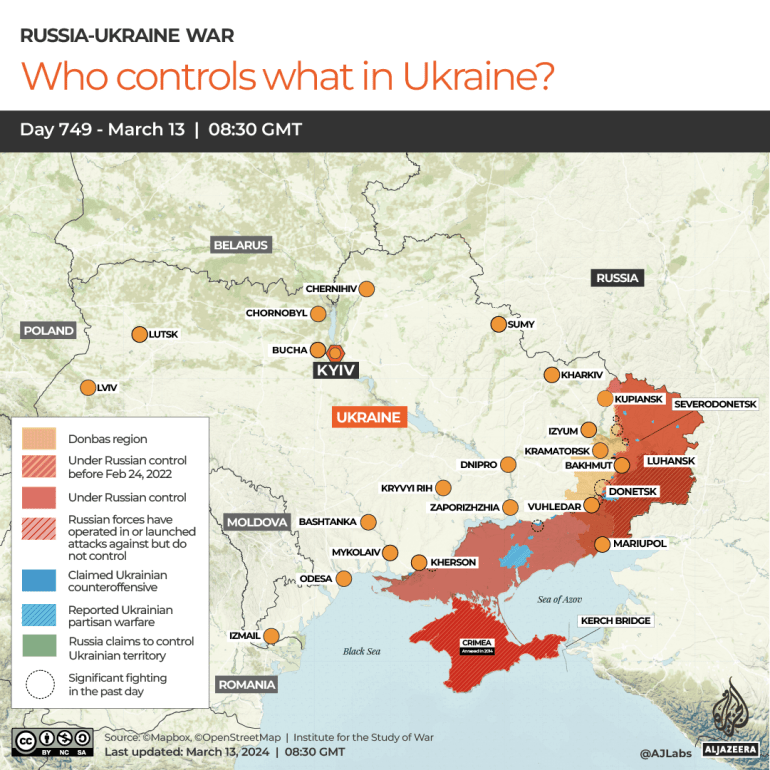
His comments, made six days after Sweden officially joined NATO as its 32nd member, were mild compared with a warning two weeks ago after French President Emmanuel Macron left open the possibility of sending troops to Ukraine.
“They must realise that we also have weapons that can hit targets on their territory. All this really threatens a conflict with the use of nuclear weapons and the destruction of civilisation. Don’t they get that?” Putin said on February 29.
Putin is running for a third consecutive six-year term.
He has passed constitutional amendments suspending a ban on more than two consecutive terms for himself personally. It allows him to rule until 2036 and has led both Russian and Western critics to label his continuing to hold office as illicit.
In October, the Council of Europe described his presidency as a “de facto dictatorship” and urged its member states to “recognise Putin as illegitimate”.
Russian crawl
Russian forces continued to make marginal advances on the eastern front for a fourth straight week after the fall of Avdiivka on February 17, but the pace of these advances has slowed considerably, suggesting Ukraine has managed to absorb Russian momentum.
On Friday, geolocated footage showed they entered the village of Tonenke and advanced towards Berdychi, both west of Avdiivka in the Donetsk region. Russian forces had already been on the edges of both settlements a week earlier.
Ukraine’s Tavria Group of forces, which is fighting in the area, said this front had stabilised.
“The advance has actually stopped. The Russian military is making small movements in this direction,” spokesperson Dmytro Lykhovyi said.
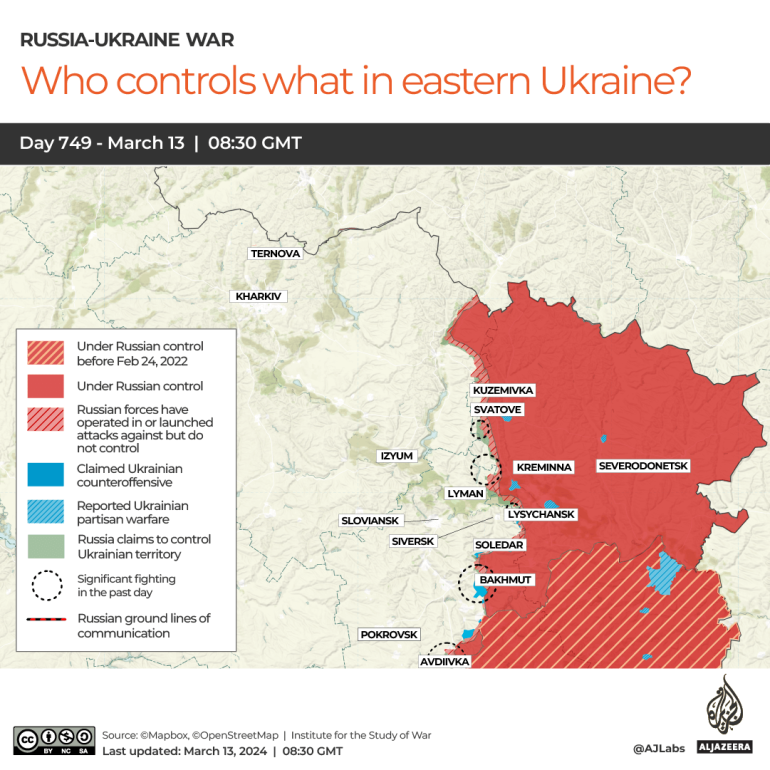
There were other minor Russian advances in Donetsk. Russian forces have been trying to roll back Ukrainian gains west of Bakhmut, and on Sunday, geolocated footage showed they had entered the village of Ivanivske.
Russian forces captured the village of Shevchenko, southeast of the city of Donetsk, on March 10 and the following day advanced in several places along the front in the area.
Towards the northern end of the front, geolocated footage showed that Russian forces approached the village of Terny from the east and reached the outskirts of Synkivka, two settlements in Donetsk and Kharkiv, respectively.
On the whole, though, these advances were measured in hundreds of metres (hundreds of yards), and the overall shape of the front remained unchanged.
What seems to continue to be instrumental in Russia’s minor successes is the use of glide bombs. These are normally massive conventional inertial bombs carrying 675kg (nearly 1,500lb) of explosives, fitted with fins and tails to fly farther and strike with greater accuracy. The German tabloid Bild reported that Russia is now mass producing the weapons.
Russian military reporters said Russia also produced an improved glide bomb design this year, including engines and satellite guidance systems that increased its range from 40-70km to 95km (25-45 miles to 60 miles).
These powered bombs enable Russian planes dropping them to fly farther away from the front, reducing their vulnerability to Ukrainian air defences, which claimed 15 aircraft in February and early March.
Ukrainian leap
While holding the front more or less steady, Ukraine focused on striking deep inside Russia.
On Saturday, several explosions were recorded in Rostov, less than 100km (60 miles) from the Ukrainian border, with at least one geolocated to a Beriev plant repairing and refurbishing A-50 radar and reconnaissance planes.
Ukraine has targeted these planes, destroying two this year, because they spy on Ukrainian positions and give fighter-bombers their coordinates.
Russia’s Ministry of Defence claimed on Saturday that it had shot down all 47 drones over four border regions, including Rostov.
On Tuesday, Ukraine again sent a large salvo of drones – this time targeting energy infrastructure. Russia’s Defence Ministry said it shot down 58.
Ryazan Governor Pavel Malkov said one drone struck the Ryazan refinery, 180km (110 miles) southeast of Moscow and about 500km (310 miles) from the Ukrainian border, starting a fire.
Ukrainian news outlet Suspilne quoted Security Service sources as saying two further refineries had been targeted, in Rostov and St Petersburg, as well as two airfields. There was no evidence that those attacks had succeeded.
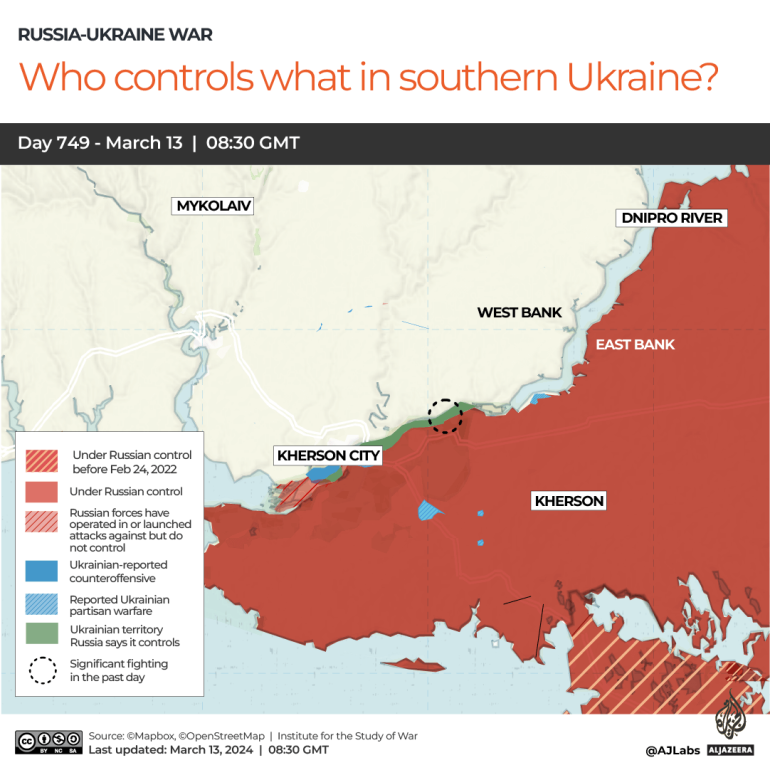
Ukraine’s military intelligence said pro-Ukrainian Russian forces had staged a border incursion on Tuesday, clashing with Russian forces in border villages in Belgorod and Kursk.
The Russian Volunteer Force and Freedom of Russia Legion are anti-Putin paramilitaries that first attacked Russia in March 2023. Russian sources first denied the incursion, then claimed to have repelled it.
Whether it succeeded in the past week, Ukraine has been following through on tactics that have succeeded in the past, striking oil refineries and sinking or disabling as much as half of Russia’s Black Sea Fleet.
But in interviews with Western media, Ukrainian fighters on the front lines are raising the alarm about shortages of ammunition as United States military aid remains frozen in a Republican-controlled House of Representatives. The latest such warning came in Germany’s Der Spiegel news magazine on Tuesday when Ukrainian servicemen warned they could not hold out forever under current conditions.
Even Ukraine’s new commander-in-chief, Oleksandr Syrskii, warned on Wednesday that “there is a threat of enemy units advancing deep into our battle formations.”
“Ukrainian shortages of ammunition and other war materiel resulting from delays in the provision of US military assistance may be making the current Ukrainian front line more fragile than the relatively slow Russian advances in various sectors would indicate,” wrote the Institute for the Study of War, a Washington-based think tank.
Ukraine’s European allies have been trying to make up for the US shortfall. Britain announced it would spend $160m buying 10,000 drones for Ukraine.
Czech officials said they had raised enough money from partners to buy 300,000 artillery shells from around the world for Ukraine.
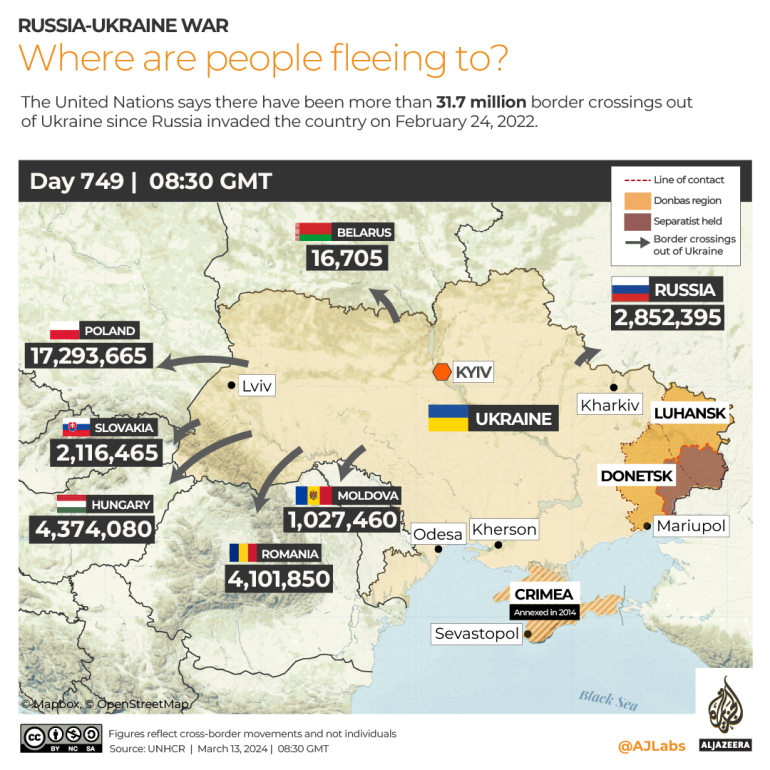
The Czech Republic is leading an effort to locate 800,000 artillery shells outside Europe and deliver them to Ukraine. Germany, which refrains from sending its medium-range Taurus missile to Ukraine because Russia said it would consider it an escalation, was reportedly discussing a plan to send the missiles to Britain as replacements for Storm Shadow missiles Britain would send to Ukraine.
The administration of US President Joe Biden said it was sending $300m of urgently needed military aid cobbled together from savings in the US defence budget. But none of this makes up for the absence of $60.1bn in military aid the US was planning to send in 2024.